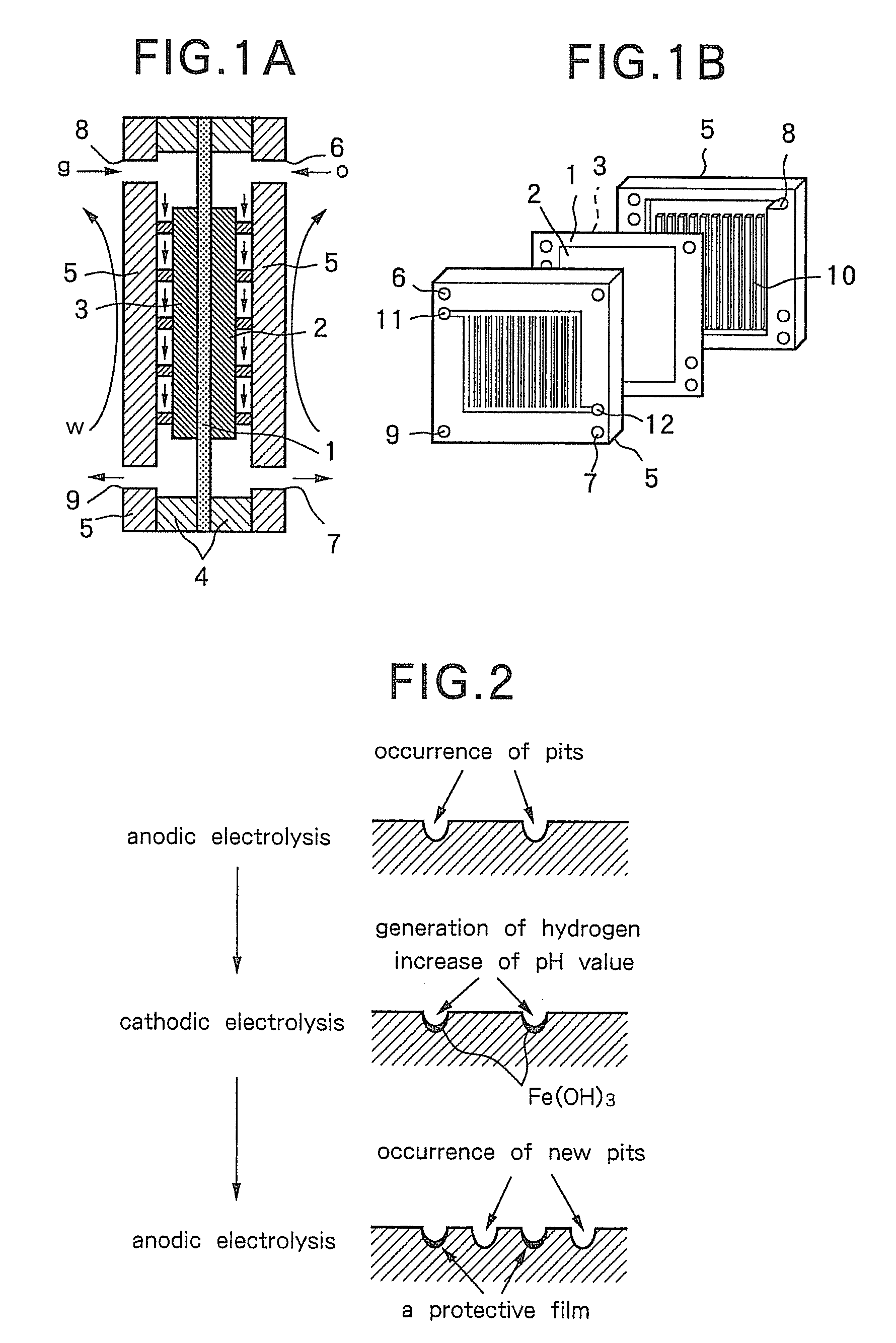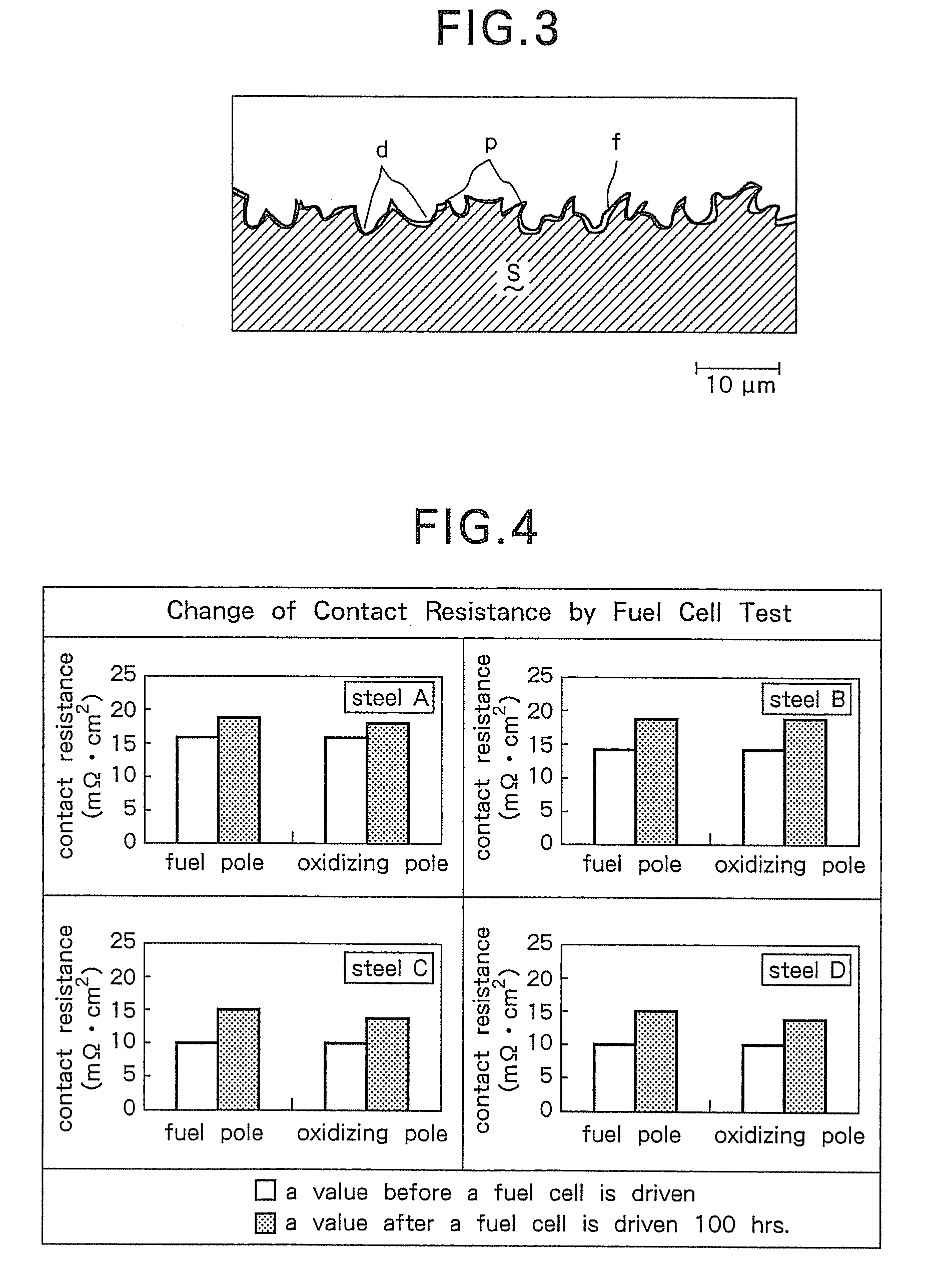Separator for Low-Temperature Type Fuel Cell and Production Method Therefor
a technology of low-temperature type and separator, which is applied in the manufacture of cell components, final product details, and cell components, etc., can solve the problems of remarkably reducing the contact resistance of stainless steel sheets by electrolytic etching in ferric chloride solution, and achieve the effect of reducing the contact resistance and without reducing the power-generating efficiency
- Summary
- Abstract
- Description
- Claims
- Application Information
AI Technical Summary
Benefits of technology
Problems solved by technology
Method used
Image
Examples
example 1
[0037]Several stainless steel sheet having compositions shown in Table 1 were used as separator material. Each stainless steel sheet was roughened by electrolytic etching.
[0038]The stainless steel sheet A was roughened by alternating electrolytic etching in a ferric chloride solution containing 20 g / l of Fe3+ at 50° C. for 60 seconds. Electrolytic etching was performed with anodic current density of 3.0 kA / m2, cathodic current density of 0.2 kA / m2 and alternating electrolysis cycles of 5 Hz.
[0039]The stainless steel sheet B was roughened by alternating electrolytic etching in a ferric chloride solution containing 55 g / l of Fe3+ at 57.5° C. for 60 seconds. Electrolytic etching was performed with anodic current density of 3.0 kA / m2, cathodic current density of 1.0 kA / m2 and alternating electrolysis cycles of 5 Hz.
[0040]The stainless steel sheet C was roughened by alternating electrolytic etching in a ferric chloride solution containing 30 g / l of Fe3+ at 50° C. for 40 seconds. Electrol...
example 2
[0046]An electrode assembly, which had a macromolecular membrane 1 stacked together with an oxidizing electrode 2 and a fuel electrode 3, was sandwiched between separators 5, 5 made from a roughened stainless steel sheet, so as to build up a fuel cell. The fuel cell was continuously driven 100 hrs. with constant current density of 0.5 A / m2, while humid hydrogen and oxygen were supplied to the fuel cell. After the 100 hrs. driving, the separators 5 were detached from the electrode assembly for investigating occurrence of corrosion. No corrosion was detected in the separators made of any stainless steel sheet A-D, and increase of contact resistance was very little as shown in FIG. 4.
[0047]A separator for a low-temperature fuel cell according to the present invention as above-mentioned, is made of a stainless steel sheet having the surface state that a lot of fine projections stand close together around numerous pits. When the stainless steel separator is stacked and pressed together w...
PUM
| Property | Measurement | Unit |
|---|---|---|
| Density | aaaaa | aaaaa |
| Density | aaaaa | aaaaa |
| Density | aaaaa | aaaaa |
Abstract
Description
Claims
Application Information
 Login to View More
Login to View More - R&D
- Intellectual Property
- Life Sciences
- Materials
- Tech Scout
- Unparalleled Data Quality
- Higher Quality Content
- 60% Fewer Hallucinations
Browse by: Latest US Patents, China's latest patents, Technical Efficacy Thesaurus, Application Domain, Technology Topic, Popular Technical Reports.
© 2025 PatSnap. All rights reserved.Legal|Privacy policy|Modern Slavery Act Transparency Statement|Sitemap|About US| Contact US: help@patsnap.com



